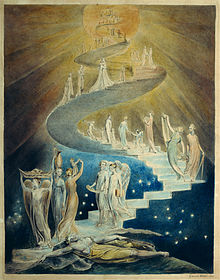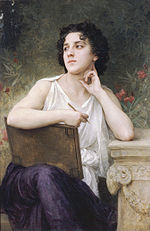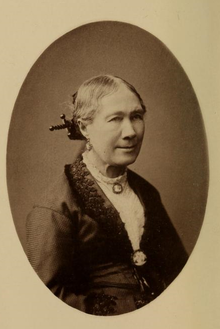From Wikipedia, the free encyclopedia/Blogger Ref http://www.p2pfoundation.net/Multi-Dimensional_Science
For other uses, see Jacob's Ladder (disambiguation).
"Ladder to Heaven" redirects here. For the South Park episode, see A Ladder to Heaven.

Picture of the Jacob's Ladder in the original Luther Bibles (of 1534 and also 1545)
Contents
[hide]Sources[edit]
The description of Jacob's ladder appears in Genesis 28:10-19:Jacob left Beersheba, and went toward Haran. He came to the place and stayed there that night, because the sun had set. Taking one of the stones of the place, he put it under his head and lay down in that place to sleep. And he dreamed, and behold, there was a ladder set up on the earth, and the top of it reached to heaven; and behold, the angels of God were ascending and descending on it! And behold, the Lord stood above it [or "beside him"] and said, "I am the Lord, the God of Abraham your father and the God of Isaac; the land on which you lie I will give to you and to your descendants; and your descendants shall be like the dust of the earth, and you shall spread abroad to the west and to the east and to the north and to the south; and by you and your descendants shall all the families of the earth bless themselves. Behold, I am with you and will keep you wherever you go, and will bring you back to this land; for I will not leave you until I have done that of which I have spoken to you." Then Jacob awoke from his sleep and said, "Surely the Lord is in this place; and I did not know it." And he was afraid, and said, "This is none other than the house of God, and this is the gate of heaven.Afterwards, Jacob names the place, "Bethel" (literally, "House of God").
Judaism[edit]
The classic Torah commentaries offer several interpretations of Jacob's ladder. According to the Midrash, the ladder signified the exiles which the Jewish people would suffer before the coming of the Messiah. First the angel representing the 70-year exile of Babylonia climbed "up" 70 rungs, and then fell "down". Then the angel representing the exile of Persia went up a number of steps, and fell, as did the angel representing the exile of Greece. Only the fourth angel, which represented the final exile of Rome/Edom (whose guardian angel was Esau himself), kept climbing higher and higher into the clouds. Jacob feared that his children would never be free of Esau's domination, but God assured him that at the End of Days, Edom too would come falling down.[citation needed]Another interpretation of the ladder keys into the fact that the angels first "ascended" and then "descended". The Midrash explains that Jacob, as a holy man, was always accompanied by angels. When he reached the border of the land of Canaan (the future land of Israel), the angels who were assigned to the Holy Land went back up to Heaven and the angels assigned to other lands came down to meet Jacob. When Jacob returned to Canaan he was greeted by the angels who were assigned to the Holy Land.
Yet another interpretation is this: The place at which Jacob stopped for the night was in reality Mount Moriah, the future home of the Temple in Jerusalem.[citation needed] The ladder therefore signifies the "bridge" between Heaven and earth, as prayers and sacrifices offered in the Holy Temple soldered a connection between God and the Jewish people. Moreover, the ladder alludes to the giving of the Torah as another connection between heaven and earth. In this interpretation, it is also significant that the Hebrew word for ladder, sulam (סלם) and the name for the mountain on which the Torah was given, Sinai (סיני) have the same gematria (numerical value of the letters).
The Hellenistic Jewish philosopher Philo, born in Alexandria, (d. ca. 50 CE) presents his allegorical interpretation of the ladder in the first book of his De somniis. There he gives four interpretations, which are not mutually exclusive:[2]
- The angels represent souls descending to and ascending from bodies (some consider this to be Philo's clearest reference to the doctrine of reincarnation).
- In the second interpretation the ladder is the human soul and the angels are God's logoi, pulling the soul up in distress and descending in compassion.
- In the third view the dream depicts the ups and downs of the life of the "practiser" (of virtue vs. sin).
- Finally the angels represent the continually changing affairs of men.
Christianity[edit]
Jesus said in John 1:51 "And he saith unto him, Verily, verily, I say unto you, Hereafter ye shall see heaven open, and the angels of God ascending and descending upon the Son of man." This statement has been interpreted as associating or implicating Jesus with the mythical ladder.[citation needed]The theme of a ladder to heaven is often used by the Church Fathers. Irenaeus in the second century describes the Christian Church as the "ladder of ascent to God".[4]
In the third century, Origen[5] explains that there are two ladders in the life of a Christian, the ascetic ladder that the soul climbs on the earth, by way of—and resulting in—an increase in virtue, and the soul's travel after death, climbing up the heavens towards the light of God.
In the fourth century, Gregory of Nazianzus[6] speaks of ascending Jacob's Ladder by successive steps towards excellence, interpreting the ladder as an ascetic path, while Saint Gregory of Nyssa narrates[7] that Moses climbed on Jacob's Ladder to reach the heavens where he entered the tabernacle not made with hands, thus giving the Ladder a clear mystical meaning. The ascetic interpretation is found also in Saint John Chrysostom, who writes:
"And so mounting as it were by steps, let us get to heaven by a Jacob’s ladder. For the ladder seems to me to signify in a riddle by that vision the gradual ascent by means of virtue, by which it is possible for us to ascend from earth to heaven, not using material steps, but improvement and correction of manners."[8]Jacob's Ladder as an analogy for the spiritual ascetic of life had a large diffusion through the classical work The Ladder of Divine Ascent by John Climacus.
Furthermore, Jesus can be seen as being the ladder, in that Christ bridges the gap between Heaven and Earth. Jesus presents himself as the reality to which the ladder points; as Jacob saw in a dream the reunion of Heaven and Earth, Jesus brought this reunion, metaphorically the ladder, into reality. Adam Clarke, an early 19th-century Methodist theologian and Bible scholar, elaborates:
That by the angels of God ascending and descending, is to be understood, that a perpetual intercourse should now be opened between heaven and earth, through the medium of Christ, who was God manifested in the flesh. Our blessed Lord is represented in his mediatorial capacity as the ambassador of God to men; and the angels ascending and descending upon the Son of Man, is a metaphor taken from the custom of dispatching couriers or messengers from the prince to his ambassador in a foreign court, and from the ambassador back to the prince.[9]
Gallery[edit]
- The angels climb Jacob's Ladder on the west front of Bath Abbey.
- Jacob's Dream Artwork on the campus of Abilene Christian University.
Pseudepigraphic apocalyptic literature[edit]
The narrative of Jacob's Ladder was used, shortly after the destruction of the Second Temple in the Siege of Jerusalem (70 CE), as basis for the pseudepigraphic Ladder of Jacob. This writing, preserved only in Old Church Slavonic, interprets the experience of Patriarchs in the context of Merkabah mysticism.Islam[edit]
Jacob is revered in Islam as a prophet and patriarch. Muslim scholars, especially of the perennialist tradition,[clarification needed] drew a parallel with Jacob's vision of the ladder and Muhammad's event of the Mi'raj.[10] The ladder of Jacob was interpreted by Muslims to be one of the many symbols of God, and many saw Jacob's ladder as representing in its form the essence of Islam, which emphasizes following the "straight path". The twentieth-century scholar Martin Lings described the significance of the ladder in the Islamic mystic perspective:The ladder of the created Universe is the ladder which appeared in a dream to Jacob, who saw it stretching from Heaven to earth, with Angels going up and down upon it; and it is also the "straight path", for indeed the way of religion is none other than the way of creation itself retraced from its end back to its Beginning.[11]
Cultural references[edit]
Jacob's Ladder has been depicted in many artworks the largest of which is the facade of Bath Abbey in England where sculptures depict angels climbing up and down ladders on either side of the main window on the west front.The name has also been applied to a number of outdoor public staircases throughout the world noted for their steepness where the religious derivation is not immediately obvious.
- Auckland and Saint Clair, in Dunedin New Zealand.
- Brisbane, Townsville, Cockburn, Perth and Castle Hill, Queensland in Australia.
- Ramsgate, Sidmouth, Falmouth, York Castle, Kinder Scout in Derbyshire, Wenlock Edge at Eaton-under-Heywood, Shropshire, Alton Towers & the Cheddar Gorge in England
- Edinburgh, Newtyle, Oban, West Dunbartonshire & Finnich Glen in Scotland.
- Devil's Bridgea, Ceredigion, in Wales.
- Truro, Nova Scotia, Canada.
- Wuppertal, Germany
- Cape Town, South Africa
- Waco, Texas, Chester in western Massachusetts, Mount Washington Cog Railway, New Hampshire and a State Park in New York, USA.
- Jamestown on the island of St Helena - this example has 699 steps, it is 900 ft in length, and ascends 600 ft (183m). It is the longest straight staircase in the world.
- Falmouth, Cornwall, UK
A type of plant (a Polemonium) is commonly called Jacob's Ladder.
The term is also used for a type of nautical rigging, a type of obstacle course involving rope ladders as well as at least two mathematical problems. Most poetic, and closest to the Biblical source, is the use of the term to describe the Crepuscular rays shining down a hole in the clouds.
See also[edit]
- Crepuscular rays
- De Jacobsladder, novel by Maarten 't Hart
- Jacob's Ladder (film), psychological thriller by Bruce Joel Rubin starring Tim Robbins
- Jacob's ladder (electricity)
- Jacob's ladder (string figure)
- Jacob's ladder (toy)
- "Locus iste" motet by Anton Bruckner
- "Nearer, My God, to Thee" hymn lyrics (written 1841) by Sarah Flower Adams
- Jacob's Ladder, a song by the progressive rock band, Rush, from their album "Permanent Waves", released in 1980.
- Jacob's Ladder, a song by Bruce Hornsby and John Hornsby, performed by Huey Lewis and the News
- Rectify, S1E6: "Jacob's Ladder"
- Stairway to Heaven (disambiguation)
References[edit]
- Jump up ^ Morris Eaves, Robert N. Essick, and Joseph Viscomi (eds.). "Jacob's Dream, object 1 (Butlin 438) "Jacob's Dream"". William Blake Archive. Retrieved September 25, 2013.
- Jump up ^ Verman, Mark (Fall 2005). "Reincarnation in Jewish Mysticism and Gnosticism (review)". Shofar 24 (1): 173–175. doi:10.1353/sho.2005.0206. Retrieved 14 June 2010.
- Jump up ^ Bresky, Ben (30 September 2012). "Sukkot Music Events Abound in Israel". Arutz Sheva. Retrieved 6 October 2012.
- Jump up ^ Irenaeus, Adversus haereses, III,24,1
- Jump up ^ Origen, Homily n. 27 on Numbers, about Nm 33:1–2
- Jump up ^ Gregory of Nazianzus, Homily n. 43 (Funeral Oration on the Great S. Basil), 71
- Jump up ^ Gregory of Nyssa, Life of Moses 224-227
- Jump up ^ John Chrysostom, The Homilies on the Gospel of St. John n. 83,5., Text from CCEL
- Jump up ^ Clarke, Adam (1817). The holy Bible, from the authorized tr., with a comm. and critical notes by A. Clarke.
- Jump up ^ The Vision of Islam, Murata and Chittick, Pg. 84
- Jump up ^ The Book of Certainty, Martin Lings, Pg. 51
- Scherman, Rabbi Nosson (1993). The Chumash. Brooklyn, NY: Mesorah Publications.
External links[edit]
| Wikimedia Commons has media related to Jacob's ladder. |






